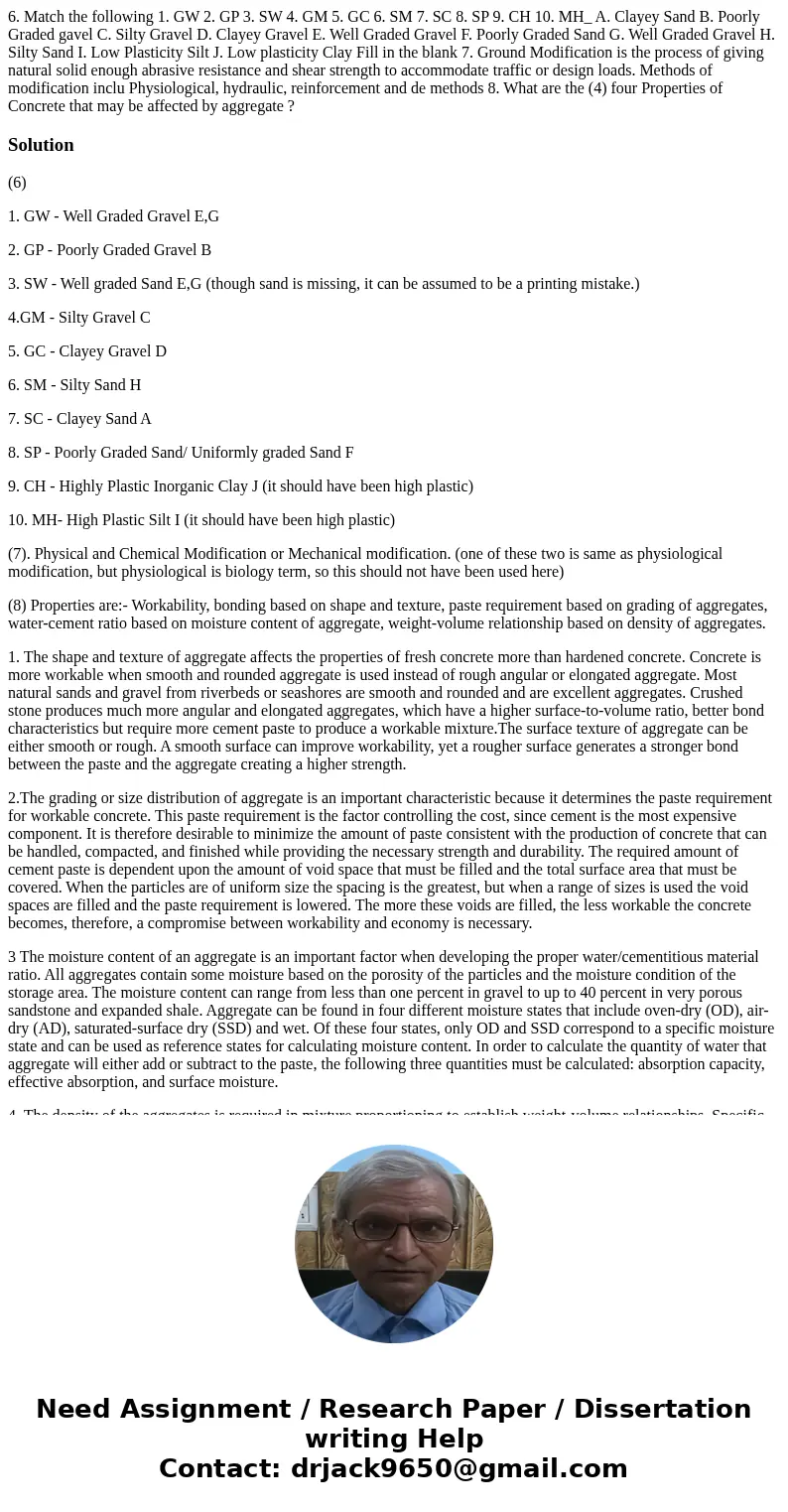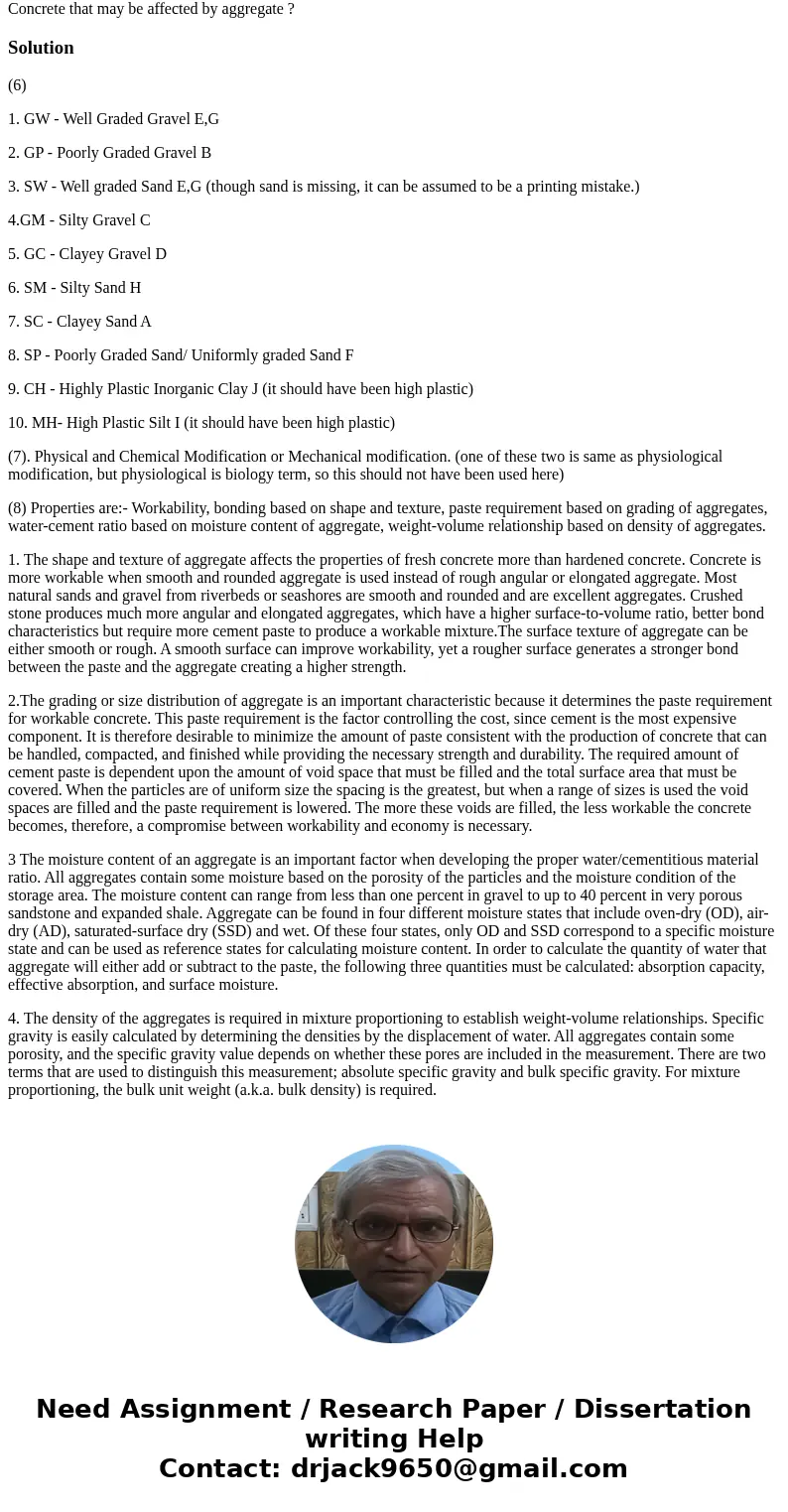6 Match the following 1 GW 2 GP 3 SW 4 GM 5 GC 6 SM 7 SC 8 S
Solution
(6)
1. GW - Well Graded Gravel E,G
2. GP - Poorly Graded Gravel B
3. SW - Well graded Sand E,G (though sand is missing, it can be assumed to be a printing mistake.)
4.GM - Silty Gravel C
5. GC - Clayey Gravel D
6. SM - Silty Sand H
7. SC - Clayey Sand A
8. SP - Poorly Graded Sand/ Uniformly graded Sand F
9. CH - Highly Plastic Inorganic Clay J (it should have been high plastic)
10. MH- High Plastic Silt I (it should have been high plastic)
(7). Physical and Chemical Modification or Mechanical modification. (one of these two is same as physiological modification, but physiological is biology term, so this should not have been used here)
(8) Properties are:- Workability, bonding based on shape and texture, paste requirement based on grading of aggregates, water-cement ratio based on moisture content of aggregate, weight-volume relationship based on density of aggregates.
1. The shape and texture of aggregate affects the properties of fresh concrete more than hardened concrete. Concrete is more workable when smooth and rounded aggregate is used instead of rough angular or elongated aggregate. Most natural sands and gravel from riverbeds or seashores are smooth and rounded and are excellent aggregates. Crushed stone produces much more angular and elongated aggregates, which have a higher surface-to-volume ratio, better bond characteristics but require more cement paste to produce a workable mixture.The surface texture of aggregate can be either smooth or rough. A smooth surface can improve workability, yet a rougher surface generates a stronger bond between the paste and the aggregate creating a higher strength.
2.The grading or size distribution of aggregate is an important characteristic because it determines the paste requirement for workable concrete. This paste requirement is the factor controlling the cost, since cement is the most expensive component. It is therefore desirable to minimize the amount of paste consistent with the production of concrete that can be handled, compacted, and finished while providing the necessary strength and durability. The required amount of cement paste is dependent upon the amount of void space that must be filled and the total surface area that must be covered. When the particles are of uniform size the spacing is the greatest, but when a range of sizes is used the void spaces are filled and the paste requirement is lowered. The more these voids are filled, the less workable the concrete becomes, therefore, a compromise between workability and economy is necessary.
3 The moisture content of an aggregate is an important factor when developing the proper water/cementitious material ratio. All aggregates contain some moisture based on the porosity of the particles and the moisture condition of the storage area. The moisture content can range from less than one percent in gravel to up to 40 percent in very porous sandstone and expanded shale. Aggregate can be found in four different moisture states that include oven-dry (OD), air-dry (AD), saturated-surface dry (SSD) and wet. Of these four states, only OD and SSD correspond to a specific moisture state and can be used as reference states for calculating moisture content. In order to calculate the quantity of water that aggregate will either add or subtract to the paste, the following three quantities must be calculated: absorption capacity, effective absorption, and surface moisture.
4. The density of the aggregates is required in mixture proportioning to establish weight-volume relationships. Specific gravity is easily calculated by determining the densities by the displacement of water. All aggregates contain some porosity, and the specific gravity value depends on whether these pores are included in the measurement. There are two terms that are used to distinguish this measurement; absolute specific gravity and bulk specific gravity. For mixture proportioning, the bulk unit weight (a.k.a. bulk density) is required.


 Homework Sourse
Homework Sourse